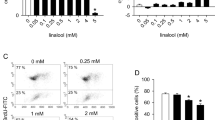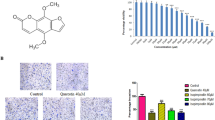Abstract
Discovery of natural compounds as effective angiogenesis inhibitors has become an important approach in the prevention of cancer. We previously demonstrated the anti-angiogenic potential of two marine algal carotenoids, fucoxanthin and siphonaxanthin. In this study, we evaluated the molecular mechanisms of the anti-angiogenic activity of those two carotenoids using human umbilical vein endothelial cells. This study showed that both fucoxanthin and siphonaxanthin suppress the mRNA expression of fibroblast growth factor 2 (FGF-2) and its receptor (FGFR-1) as well as their trans-activation factor, EGR-1. But, the mRNA expression of VEGFR-2 did not show significant effect by those two carotenoids. Further, those two marine algal carotenoids down-regulate the phosphorylation of FGF-2-mediated intracellular signaling proteins such as ERK1/2 and Akt. Inhibition of FGF-2-mediated intracellular signaling proteins by those carotenoids represses the migration of endothelial cells as well as their differentiation into tube-like structures on Matrigel. These results demonstrate for the first time the possible molecular mechanism underlying the anti-angiogenic effects of fucoxanthin and siphonaxanthin and suggest that these effects are due to the down-regulation of signal transduction by FGFR-1. Our findings imply a new insight into the novel bio-functional property of marine algal carotenoids which should improve current anti-angiogenic therapies in the treatment of cancer and other pro-angiogenic diseases.






Similar content being viewed by others
References
Folkman J, Shing Y (1992) Angiogenesis. J Biol Chem 267:10931–10934
Carmeliet P, Jain RK (2000) Angiogenesis in cancer and other diseases. Nature 407:249–257
Folkman J (1995) Angiogenesis in cancer, vascular, rheumatoid and other disease. Nat Med 1:27–30
Virmani R, Kolodgie FD, Burke AP, Fin AV, Gold HK, Tulenko TN, Wrenn SP, Narula J (2005) Atherosclerotic plaque progression and vulnerability to rupture: angiogenesis as a source of intraplaque hemorrhage. Atheroscler Thromb Vasc Biol 25:2054–2061
Qian DZ, Wang X, Kachhap SK, Kato Y, Wei Y, Zhang L, Atadja P, Pili R (2004) The histone deacetylase inhibitor NVP-LAQ824 inhibits angiogenesis and has a greater anti-tumor effect in combination with the vascular endothelial growth factor receptor tyrosine kinase inhibitor PTK787/ZK222584. Cancer Res 64:6626–6634
Hicklin DJ, Ellis LM (2005) Role of vascular endothelial growth factor pathway in tumor growth and angiogenesis. J Clin Oncol 23:1011–1027
Folkman J (2002) Looking for a good endothelial address. Cancer Cell 1:113–115
Casanovas O, Hicklin DJ, Bergers G, Hanahan D (2005) Drug resistance by evasion of antiangiogenic targeting of VEGF signaling in late-stage pancreatic islet tumors. Cancer Cell 8:299–309
Kerbel RS (2005) Therapeutic implications of intrinsic or induced angiogenic growth factor redundancy revealed. Cancer Cell 8:269–271
Ferrara N (1999) Vascular endothelial growth factor: molecular and biological aspects. Curr Top Microbiol Immunol 237:1–30
Yancopoulos GD, Davis S, Gale NW, Rudge JS, Wiegand SJ, Holash J (2000) Vascular-specific growth factors and blood vessel formation. Nature 407:242–248
Vinals F, Pouyssegur J (2001) Transforming growth factor β1 (TGF-β1) promotes endothelial cell survival during in vitro angiogenesis via an autocrine mechanism implicating TGF-α signaling. Mol Cell Biol 21:7218–7230
Ferrara N, Kerbel RS (2005) Angiogenesis as a therapeutic target. Nature 438:967–974
Folkman J (2007) Angiogenesis: an organizing principle for drug discovery. Nat Rev 6:273–286
Garber K (2002) Angiogenesis inhibitors suffer new setback. Nat Biotechnol 20:1067–1068
Kamba T, McDonald DM (2007) Mechanisms of adverse effects of anti-VEGF therapy for cancer. Br J Cancer 96:1788–1795
Albini A, Noonan DM, Ferrari N (2007) Molecular pathways for cancer angioprevention. Clin Cancer Res 13:4320–4325
Cao Y (2004) Antiangiogenic cancer therapy. Semin Cancer Biol 14:139–145
Sagar SM, Yance D, Wong RK (2006) Natural health products that inhibit angiogenesis: a potential source for investigational new agents to treat cancer. Curr Oncol 13:14–26
Sugawara T, Matsubara K, Akagi R, Mori M, Hirata T (2006) Antiangiogenic activity of brown algae fucoxanthin and its deacetylated product, fucoxanthinol. J Agric Food Chem 54:9805–9810
Ganesan P, Matsubara K, Ohkubo T, Tanaka Y, Noda K, Sugawara T, Hirata T (2010) Anti-angiogenic effect of siphonaxanthin from green alga, Codium fragile. Phytomedicine 17:1140–1144
Sugawara T, Yamashita K, Asai A, Nagao A, Shiraishi T, Imai I, Hirata T (2009) Esterification of xanthophylls by human intestinal Caco-2 cells. Arch Biochem Biophys 483:205–212
Ganesan P, Noda K, Manabe Y, Ohkubo T, Tanaka Y, Maoka T, Sugawara T, Hirata T (2011) Siphonaxanthin, a marine algal carotenoids from green algae, effectively induces apoptosis in human leukemia (HL-60) cells. Biochim Biophys Acta 1810:497–503
Matsubara K, Xue C, Zhao X, Mori M, Sugawara T, Hirata T (2005) Effects of middle molecular weight fucoidans on in vitro and ex vivo angiogenesis of endothelial cells. Int J Mol Med 15:695–699
Shing Y, Folkman J, Sullivan R, Butterfield C, Murray J, Klagsbrun M (1984) Heparin affinity: purification of a tumor-derived capillary endothelial cell growth factor. Science 223:1296–1299
Cross MJ, Claesson-Welsh L (2001) FGF and VEGF function in angiogenesis: signaling pathways, biological responses and therapeutic inhibition. Trends Pharmacol Sci 22:201–207
Wang D, Mayo MW Jr, Balswin AS (1997) Basic fibroblast growth factor transcriptional autoregulation requires Egr-1. Oncogene 14:2291–2299
Santiago FS, Lowe HC, Day FL, Chesterman CN, Khachigian LM (1999) Early growth response factor-1 induction by injury is triggered by release and paracrine activation by fibroblast growth factor-2. Am J Pathol 154:937–944
Montesano R, Orci L, Vassalli P (1983) In vitro rapid organization of endothelial cells into capillary-like networks is promoted by collagen matrices. J Cell Biol 97:1648–1652
Dailey L, Ambrosetti D, Mansukhani A, Basilico C (2005) Mechanisms underlying differential responses to FGF-signaling. Cytokine Growth Factor Rev 16:233–247
Feng X, Ofstad W, Hawkins D (2010) Antiangiogenesis therapy: a new strategy for cancer treatment. US Pharm 35:4–9
Al-Jamal KT, Al-Jamal WT, Akerman S, Podesta JE, Yilmazer A, Turton JA, Bianco A, Vargesson N, Kanthou C, Florence AT, Tozer GM, Kostarelos K (2010) Systemic anti-angiogenic activity of cationic poly-l-lysine dendrimer delays tumor growth. Proc Natl Acad Sci USA 107:3966–3971
Turner N, Grose R (2010) Fibroblast growth factor signaling: from development to cancer. Nat Rev 10:116–129
Ferrara N, Gerber HP, LeCouter J (2003) The biology of VEGF and its receptors. Nat Med 9:669–676
Fahmy RG, Dass CR, Sun L, Chesterman CN, Khachigian LM (2003) Transcription factor Egr-1 supports FGF-dependent angiogenesis during neovascularization and tumor growth. Nat Med 9:1026–1032
Altomare DA, Testa JR (2005) Perturbation of the AKT signaling pathway in human cancer. Oncogene 24:7455–7464
Eswarakumar VP, Lax I, Schlessinger J (2005) Cellular signaling by fibroblast growth factor receptors. Cytokine Growth Factor Rev 16:139–149
Hood JD, Frausto R, Kiosses WB, Schwartz MA, Cheresh DA (2003) Differential αv integrin-mediated Ras–ERK signaling during two pathways of angiogenesis. J Cell Biol 162:933–943
Eliceiri BP, Klemke R, Strömblad S, Cheresh DA (1998) Integrin αvβ3 requirement for sustained mitogen-activated protein kinase activity during angiogenesis. J Cell Biol 140:1255–1263
Nicholson KM, Anderson NG (2002) The protein kinase B/Akt signaling pathway in human malignancy. Cell Signal 14:381–395
Kok TW, Yue PYK, Mak NK, Fan TPD, Liu L, Wong RNS (2005) The anti-angiogenic effect of sinomenine. Angiogenesis 8:3–12
Hussain S, Slevin M, Matou S, Ahmed N, Choudhary MI, Ranjit R, West D, Gaffney J (2008) Anti-angiogenic activity of sesterterpenes: natural product inhibitors of FGF-2-induced angiogenesis. Angiogenesis 11:245–256
Peng C, Pan S, Lee K, Bastow KF, Tend C (2008) Molecular mechanism of the inhibitory effect of KS-5 on FGF-2-induced angiogenesis in vitro and in vivo. Cancer Lett 263:114–121
Miyazawa T, Shibata A, Sookwong P, Kawakami Y, Eitsuka T, Asai A, Oikawa S, Nakagawa K (2009) Anti-angiogenic and anti-cancer potential of unsaturated vitamin E (tocotrienol). J Nutr Biochem 20:79–86
Sugawara T, Baskaran V, Tsuzuki W, Nagao A (2002) Brown algae fucoxanthin is hydrolyzed to fucoxanthinol during absorption by Caco-2 human intestinal cells and mice. J Nutr 132:946–951
Asai A, Sugawara T, Ono H, Nagao A (2004) Biotransformation of fucoxanthinol to amarouciaxanthin A in mice and HepG2 cells: formation and cytotoxicity of fucoxanthin metabolites. Drug Metab Dispos 32:205–211
Carmeliet P (2005) Angiogenesis in life, disease and medicine. Nature 438:932–936
Acknowledgments
This research was supported by the Ministry of Education, Culture, Sports, Science and Technology (MEXT), the Government of Japan, the Kieikai Research Foundation and a Grant-in-Aid for Scientific Research (B) (23380124), Japan.
Conflict of interest
The authors declare no potential conflict of interest.
Author information
Authors and Affiliations
Corresponding author
Rights and permissions
About this article
Cite this article
Ganesan, P., Matsubara, K., Sugawara, T. et al. Marine algal carotenoids inhibit angiogenesis by down-regulating FGF-2-mediated intracellular signals in vascular endothelial cells. Mol Cell Biochem 380, 1–9 (2013). https://doi.org/10.1007/s11010-013-1651-5
Received:
Accepted:
Published:
Issue Date:
DOI: https://doi.org/10.1007/s11010-013-1651-5




